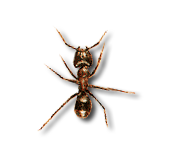General Characteristics:
- 1/4 -1/2 inches in length
- Large, many sizes (polymorphic) ranging from ¼ to ¾ inches and black bodied
- 1 segmented waist between thorax and abdomen
- elbowed antennae with long first segment and 11 smaller segments
- polymorphic (multiple sizes in colonies) = Queens usually larger and workers are smaller
- Nests in deadwood, felled trees, poles and other wooden structures
- Bites but cannot sting
- Unlike termites, carpenter ants do not eat wood (cellulose), they only nest in it
- Feeds on other insects, meats, greases, fats, fruit juices or other sugars
Reproduction:
- Nesting in hollowed out wooden cavities, the brood chambers host the eggs, larvae and pupae inside silken cases
- Usually one egg laying queen per colony
- 2000 to 3000 ants in mature colony
- Workers guard nest, gather food, explore and fight off threats
- Winged reproductives generally swarm in the spring, but are not limited to this time of the year
Signs of Infestation:
- Workers lay down pheromone trails that others follow, so ants may be seen following similar patterns of movement
- Wooden structures that are rotting or water-logged from previous damage are especially susceptible to this species of ant
- Winged reproductives may swarm inside or outside structure during the spring or occasionally at other times
- Small plies of wooden fragments, insect parts and ground material can help identify nest location(s), but this is not always present
Control Techniques:
- Keeping the structure dry and ensuring that and water damaged wood is repaired promptly is key to avoiding infestation
- Sanitation of organic debris will reduce interior food supply and make structure less conducive to carpenter ant usage
- Due to the risk of reduced structural integrity, a professional should be contacted to assess the level of damage and remove colony or colonies from the structure before repairs commence
Please click here to contact a Focus Pest Control professional to inquire about further treatments for this pest species.
References:
Benett, Gary W., et.al.. Truman’s Scientific Guide to Pest Control Operations. Duluth: Advanstar Communications, 1988. Pp. 185-186.
Milne, Louis and Margery. National Audubon Society Field Guide to North American Insects and Spiders. New York:Alfred A Knopf, 1997. p.824.
Disclaimer:
The Focus Pest Control ‘Pest Library’ is an educational resource written largely to educate the general public about common pests in Ontario. The Focus ‘Pest Library’ does not include all species in Ontario, nor does it include the most recent scientific data about species we describe. Though we edit our accounts for accuracy, we cannot guarantee all information in those accounts. While Focus Pest Control staff and contributors provide references to books and websites that we believe are reputable, we cannot necessarily endorse the contents of references beyond our control.
(Back to top)
|


